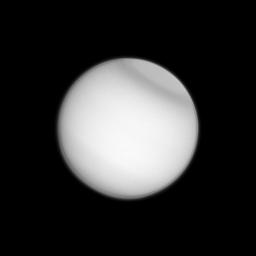
|
Titan’s Fancy Collar
- Click the image above for a larger view
- Full-Res JPEG (987 x 987) (27.1 kB)
- Full-Res TIFF (987 x 987) (975.4 kB)
Caption:
Titan's polar collar -- previously seen by Voyager 2 and the Hubble Space Telescope -- has now been observed by the Cassini spacecraft, seen here in ultraviolet light. The collar is believed to be seasonal in nature. Researchers are still studying its cause and evolution.
This view looks toward the Saturn-facing hemisphere of Titan. North on Titan is up and rotated 32 degrees to the right. The image was taken with the Cassini spacecraft narrow-angle camera on April 13, 2013 using a spectral filter sensitive to wavelengths of ultraviolet light centered at 338 nanometers.
The view was acquired at a distance of approximately 1.1 million miles (1.8 million kilometers) from Titan and at a Sun-Titan-spacecraft, or phase, angle of 4 degrees. Image scale is 7 miles (11 kilometers) per pixel.
Background Info:
The Cassini-Huygens mission is a cooperative project of NASA, the European Space Agency and the Italian Space Agency. The Jet Propulsion Laboratory, a division of the California Institute of Technology in Pasadena, manages the mission for NASA's Science Mission Directorate, Washington, D.C. The Cassini orbiter and its two onboard cameras were designed, developed and assembled at JPL. The imaging operations center is based at the Space Science Institute in Boulder, Colo.
For more information about the Cassini-Huygens mission visit http://saturn.jpl.nasa.gov and http://www.nasa.gov/cassini . The Cassini imaging team homepage is at http://ciclops.org .
Cataloging Keywords:
| Name | Value | Additional Values |
|---|---|---|
| Target | Titan | Saturn |
| System | Saturn | |
| Target Type | Satellite | Planet |
| Mission | Cassini-Huygens | Hubble Space Telescope (HST), Voyager |
| Instrument Host | Cassini Orbiter | Hubble Space Telescope |
| Host Type | Orbiter | Flyby Spacecraft, Space Telescope |
| Instrument | Imaging Science Subsystem (ISS) | |
| Detector | Narrow Angle Camera | |
| Extra Keywords | Grayscale, Rotation, Ultraviolet, Visual | |
| Acquisition Date | ||
| Release Date | 2013-08-26 | |
| Date in Caption | 2013-04-13 | |
| Image Credit | NASA/JPL-Caltech/Space Science Institute | |
| Source | photojournal.jpl.nasa.gov/catalog/PIA17124 | |
| Identifier | PIA17124 | |
